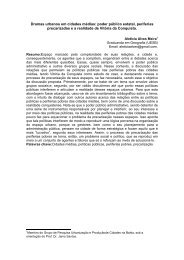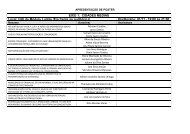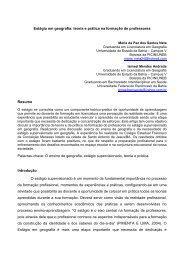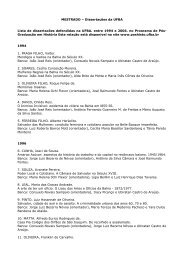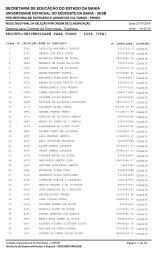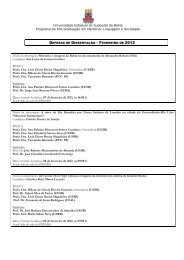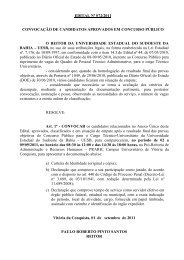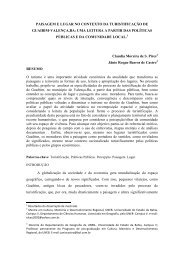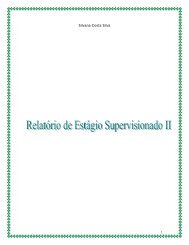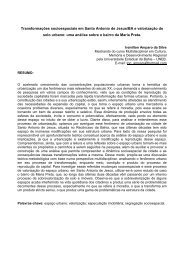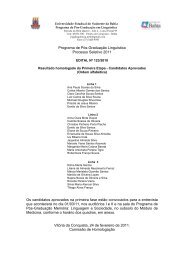os instrumentos de gestão ea epidemiologia: ferramentas do ... - Uesb
os instrumentos de gestão ea epidemiologia: ferramentas do ... - Uesb
os instrumentos de gestão ea epidemiologia: ferramentas do ... - Uesb
Create successful ePaper yourself
Turn your PDF publications into a flip-book with our unique Google optimized e-Paper software.
ISSN: 1981-8963<br />
DOI: 10.5205/reuol.3049-24704-1-LE.070120126<br />
Oliveira JS, Nery AA, Vilela ABA et al. The management tools and the epi<strong>de</strong>miology…<br />
ORIGINAL ARTICLE<br />
THE MANAGEMENT TOOLS AND THE EPIDEMIOLOGY: THE TOOLS OF THE<br />
SOCIAL CONTROL<br />
OS INSTRUMENTOS DE GESTÃO E A EPIDEMIOLOGIA: FERRAMENTAS DO CONTROLE SOCIAL<br />
INSTRUMENTOS DE GESTIÓN Y EPIDEMIOLOGÍA: HERRAMIENTAS DE CONTROL SOCIAL.<br />
Juliana Silva Oliveira 1 , Adriana Alves Nery 2 , Alba Benemérita Alves Vilela 3 , Charles Souza Sant<strong>os</strong>4, Karla<br />
Christina <strong>de</strong> Albuquerque Bispo 5 , Luciene Dias Bispo 6<br />
ABSTRACT�<br />
Objective: to verify the knowledge of the local advisors on the epi<strong>de</strong>miology and the basic management tools<br />
in the Brazilian Unified H<strong>ea</strong>lth System. Method: this is a <strong>de</strong>scriptive and exploratory study with a qualitative<br />
approach. It had as subjects the local h<strong>ea</strong>lth advisors from the city of Jequié / BA / Brazil. Data were<br />
collected through a semi-structured questionnaire, later, they were examined in the light of the Content<br />
Analysis, after the approval of the res<strong>ea</strong>rch project by the Ethics Res<strong>ea</strong>rch Committee, following the norms of<br />
the Resolution 196/96, un<strong>de</strong>r the Protocol number 106/11. Results: after r<strong>ea</strong>ding the collected material, the<br />
following categories were <strong>de</strong>fined > and >. The h<strong>ea</strong>lth advisors still did not have necessary knowledge on the h<strong>ea</strong>lth<br />
indicators and the basic management tools. Conclusion: the lack of knowledge is hin<strong>de</strong>ring the performance<br />
of the advisors in controlling, supervision and resolution on the h<strong>ea</strong>lth of the municipality. Descriptors:<br />
Epi<strong>de</strong>miology; H<strong>ea</strong>lth Management; Social Participation.<br />
RESUMO<br />
Objetivo: verificar o conhecimento d<strong>os</strong> conselheir<strong>os</strong> municipais <strong>de</strong> saú<strong>de</strong> acerca da epi<strong>de</strong>miologia e d<strong>os</strong><br />
instrument<strong>os</strong> básic<strong>os</strong> <strong>de</strong> <strong>gestão</strong> <strong>do</strong> Sistema Único <strong>de</strong> Saú<strong>de</strong>. Méto<strong>do</strong>: estu<strong>do</strong> <strong>de</strong>scritivo e exploratório com<br />
abordagem qualitativa. Tiveram como sujeit<strong>os</strong> <strong>os</strong> conselheir<strong>os</strong> municipais <strong>de</strong> saú<strong>de</strong> <strong>de</strong> Jequié/BA/Brasil. Os<br />
dad<strong>os</strong> foram coletad<strong>os</strong> por meio <strong>de</strong> um questionário semiestrutura<strong>do</strong>, em seguida, examinad<strong>os</strong> à luz da<br />
Análise <strong>de</strong> Conteú<strong>do</strong>, <strong>de</strong>pois da aprovação <strong>do</strong> projeto <strong>de</strong> pesquisa pelo Comitê <strong>de</strong> Ética, seguin<strong>do</strong> as normas<br />
da Resolução 196/96, sob o Protocolo <strong>de</strong> número 106/11. Resultad<strong>os</strong>: após a leitura <strong>do</strong> material coleta<strong>do</strong><br />
foram <strong>de</strong>finidas as categorias > e >. Os conselheir<strong>os</strong> <strong>de</strong> saú<strong>de</strong> ainda não p<strong>os</strong>suiam conheciment<strong>os</strong> necessári<strong>os</strong><br />
sobre indica<strong>do</strong>res <strong>de</strong> saú<strong>de</strong> e <strong>os</strong> instrument<strong>os</strong> básic<strong>os</strong> <strong>de</strong> <strong>gestão</strong>. Conclusão: a falta <strong>do</strong> conhecimento vem<br />
dificultan<strong>do</strong> a atuação d<strong>os</strong> conselheir<strong>os</strong> no controle, fiscalização e <strong>de</strong>liberação sobre a saú<strong>de</strong> <strong>do</strong> município.<br />
Descritores: Epi<strong>de</strong>miologia; Gestão em Saú<strong>de</strong>; Participação Social.<br />
RESUMEN�<br />
Objetivo: verificar el conocimiento <strong>de</strong> l<strong>os</strong> consejer<strong>os</strong> municipales <strong>de</strong> sanidad sobre la epi<strong>de</strong>miología e<br />
instrument<strong>os</strong> básic<strong>os</strong> <strong>de</strong> gestión <strong>de</strong>l Sistema <strong>de</strong> Sanidad Pública. Méto<strong>do</strong>: estudio <strong>de</strong>scriptivo y exploratorio<br />
con abordaje cualitativo. L<strong>os</strong> sujet<strong>os</strong> <strong>de</strong> estudio fueron l<strong>os</strong> consejer<strong>os</strong> municipales <strong>de</strong> sanidad <strong>de</strong> Jequié<br />
(Bahía, Brasil). Se recabaron l<strong>os</strong> dat<strong>os</strong> por medio <strong>de</strong> un cuestionario semi-estructura<strong>do</strong>, en seguida,<br />
examinad<strong>os</strong> a la luz <strong>de</strong>l Análisis <strong>de</strong> Conteni<strong>do</strong>, tras aprobación <strong>de</strong>l proyecto <strong>de</strong> investigación por el Comité <strong>de</strong><br />
Ética, siguien<strong>do</strong> las normas <strong>de</strong> la Resolución 196/96, bajo protocolo nº 106/11. Resultad<strong>os</strong>: tras la lectura <strong>de</strong>l<br />
material reuni<strong>do</strong> se <strong>de</strong>finieron las categorías y >. L<strong>os</strong> consejer<strong>os</strong> <strong>de</strong> sanidad<br />
todavía no tenían conocimient<strong>os</strong> necesari<strong>os</strong> sobre indica<strong>do</strong>res <strong>de</strong> sanidad y l<strong>os</strong> instrument<strong>os</strong> básic<strong>os</strong> <strong>de</strong><br />
gestión. Conclusión: la falta <strong>de</strong> conocimiento viene dificultan<strong>do</strong> la actuación <strong>de</strong> l<strong>os</strong> consejer<strong>os</strong> en el control,<br />
fiscalización y <strong>de</strong>liberación sobre la sanidad <strong>de</strong>l municipio. Descriptores: Epi<strong>de</strong>miología; Gestión en Sanidad;<br />
Participación Social.<br />
1,2 Nurses, PHDs from Universida<strong>de</strong> Estadual <strong>do</strong> Su<strong>do</strong>este da Bahia/UESB -Campus from Jequié. Jequié (BA), Brazil. E-mails:<br />
aanery@gmail.com; albavilela@gmail.com; 3,4,5,6 Nurses, Stu<strong>de</strong>nts of the P<strong>os</strong>t-Graduate Program – Master’s Stu<strong>de</strong>nt in Nursing, from<br />
Universida<strong>de</strong> Estadual <strong>do</strong> Su<strong>do</strong>este da Bahia/UESB - Campus from Jequié. Jequié (BA), Brazil. E-mails: charlesenfzeus@hotmail.com;<br />
juli.silva.oliveira@gmail.com; karllaalbuquerque@yahoo.com.br; lutebispo@gmail.com�<br />
English/Portuguese<br />
J Nurs UFPE on line. 2013 Jan;7(1):192-8 192
ISSN: 1981-8963<br />
DOI: 10.5205/reuol.3049-24704-1-LE.070120126<br />
Oliveira JS, Nery AA, Vilela ABA et al. The management tools and the epi<strong>de</strong>miology…<br />
INTRODUCTION<br />
Changes in the h<strong>ea</strong>lth sector driven by the<br />
innovative thinking from Sanitary Reform in<br />
Brazil favored popular participation in<br />
<strong>de</strong>cisions on the operation and regulation of<br />
the Brazilian Unified H<strong>ea</strong>lth System - Sistema<br />
Único <strong>de</strong> Saú<strong>de</strong> (SUS). The organic laws of<br />
h<strong>ea</strong>lth (Law 8.080/90 and Law 8.142/90) were<br />
formulated to ensure the gui<strong>de</strong>lines and<br />
principles of the SUS, including the Social<br />
Control. Hence, every citizen had the<br />
opportunity to participate, through legal<br />
courts, of the training and the<br />
implementation of actions that re<strong>de</strong>fined the<br />
h<strong>ea</strong>lth sector. 1,2<br />
The Organic Law of H<strong>ea</strong>lth <strong>de</strong>fines that the<br />
h<strong>ea</strong>lth boards should act in formulating<br />
strategies and in control of the execution of<br />
the h<strong>ea</strong>lth policy in the corresponding court,<br />
including the economic and financial aspects.<br />
Also in this sense, it is important to highlight<br />
that the Resolution nº 333/2003, from the<br />
Brazilian National H<strong>ea</strong>lth Council, discusses<br />
the skills of councils and states that it is up to<br />
these to set gui<strong>de</strong>lines for elaboration of<br />
h<strong>ea</strong>lth plans and <strong>de</strong>liberate about them<br />
according to the different epi<strong>de</strong>miological<br />
situations and the organizational ability of the<br />
services and, furthermore, analyze, discuss<br />
and approve the management report, with<br />
accountability and financial information. 3<br />
Thus, we can state that the legal<br />
framework of the SUS inserts the h<strong>ea</strong>lth<br />
boards in the arena of h<strong>ea</strong>lth planning, which<br />
requires an approximation of these social<br />
actors with the basic tools of management<br />
a<strong>do</strong>pted un<strong>de</strong>r the scope of the Planning<br />
System of the SUS (PLANEJASUS), namely, the<br />
H<strong>ea</strong>lth Plan, the Annual H<strong>ea</strong>lth Programming<br />
and the Management Report. 4<br />
According to Vieira, the PLANEJASUS<br />
<strong>de</strong>fines as H<strong>ea</strong>lth Plan the instrument that,<br />
from a situational analysis, presents the<br />
intentions and results to be pursued in a<br />
period of four y<strong>ea</strong>rs, expressed in objectives,<br />
gui<strong>de</strong>lines and goals. The Annual H<strong>ea</strong>lth<br />
Programming is the instrument that<br />
operationalizes the intentions expressed in<br />
the H<strong>ea</strong>lth Plan, as the Annual Management<br />
Report is the instrument that presents the<br />
results achieved with the implementation of<br />
the Annual H<strong>ea</strong>lth Programming. 5<br />
The insertion of the social participation in<br />
h<strong>ea</strong>lth planning led us to the Mario Testa<br />
approaching, that emphasizes the importance<br />
of the popular participation in the elaboration<br />
process of programmatic and strategic<br />
prop<strong>os</strong>als, by f<strong>os</strong>tering internal organizational<br />
forms, <strong>de</strong>mocratic, for the building of equity<br />
and changing of the power relationships, with<br />
collaborative t<strong>ea</strong>m and enabling the social<br />
participation, with the aim that the<br />
population becomes an actor of this process. 5<br />
Other authors consi<strong>de</strong>r the planning as a<br />
technical and political process, aspects which<br />
cannot be separated. Thus, participation<br />
cannot be un<strong>de</strong>rstood only in one of these<br />
aspects. Or the planning integrally<br />
incorporates participation in the technical and<br />
political sense or incorporation which<br />
<strong>de</strong>velops itself only in the political sense will<br />
not represent a participatory planning. 6<br />
Thus, we believe that the h<strong>ea</strong>lth planning<br />
in its technical dimension presupp<strong>os</strong>es the<br />
knowledge of the local sanitary r<strong>ea</strong>lity, by<br />
a<strong>do</strong>pting the h<strong>ea</strong>lth needs of population and<br />
the use of epi<strong>de</strong>miological rationality to<br />
direct the formulation of policies for the<br />
sector, as well as the assessment on the<br />
implementation of these policies, linked to<br />
the i<strong>de</strong>a that it is necessary to enhance the<br />
p<strong>os</strong>sibilities of <strong>de</strong>cision-making in a<br />
<strong>de</strong>centralized manner, un<strong>de</strong>rstood as the<br />
political dimension of the h<strong>ea</strong>lth planning,<br />
giving to all stakehol<strong>de</strong>rs a gr<strong>ea</strong>ter autonomy<br />
of action, in or<strong>de</strong>r to enlarge the spaces of<br />
cr<strong>ea</strong>tivity and daring in seeking solutions.<br />
In this sense, the articulation and<br />
involvement of social control instances for<br />
discussion and implementation of this process<br />
of h<strong>ea</strong>lth planning has been pretty incipient. 5<br />
We cannot fail to emphasize the importance<br />
of interpretation of the h<strong>ea</strong>lth indicators for<br />
the follow-up of actions in municipalities. It is<br />
a fact that the representativeness in the<br />
councils when equally encompasses users,<br />
h<strong>ea</strong>lth workers and service provi<strong>de</strong>rs requires<br />
an un<strong>de</strong>rstanding about these, often, far away<br />
from their daily activities.<br />
The m<strong>ea</strong>surement of the h<strong>ea</strong>lth status of<br />
communities associated with the h<strong>ea</strong>lth<br />
conditions has represented a constant<br />
challenge for agencies wishing to promote<br />
actions to change this r<strong>ea</strong>lity. 7 In everyday of<br />
the h<strong>ea</strong>lth councils emerges the need for<br />
<strong>de</strong>epening these issues for the un<strong>de</strong>rstanding<br />
of the <strong>de</strong>veloped h<strong>ea</strong>lth practices and the<br />
h<strong>ea</strong>lth-dis<strong>ea</strong>se process that perm<strong>ea</strong>te<br />
communities.<br />
For the exercise of social control, the<br />
h<strong>ea</strong>lth councils take responsibility in the face<br />
of the <strong>de</strong>ployment of public policies, in or<strong>de</strong>r<br />
to promote h<strong>ea</strong>lth. The h<strong>ea</strong>lth board needs to<br />
use tools based on indicators to monitor and<br />
assess the h<strong>ea</strong>lth situation in the municipality.<br />
The h<strong>ea</strong>lth boards configured themselves in<br />
the competence that the society exerts for<br />
intervening in public management, putting<br />
the State's actions in directing of the interests<br />
English/Portuguese<br />
J Nurs UFPE on line. 2013 Jan;7(1):192-8 193
ISSN: 1981-8963<br />
DOI: 10.5205/reuol.3049-24704-1-LE.070120126<br />
Oliveira JS, Nery AA, Vilela ABA et al. The management tools and the epi<strong>de</strong>miology…<br />
of the population. Such conjecture allows the<br />
population the right to supervise the State’s<br />
actions, in accordance with public policies,<br />
within the levels of <strong>ea</strong>ch sphere of the<br />
government. 8<br />
Given the above mentioned, it is<br />
un<strong>de</strong>rstood that the approaching of h<strong>ea</strong>lth<br />
councils with the epi<strong>de</strong>miology and basic<br />
management tools and, consequently, the<br />
practices of h<strong>ea</strong>lth planning configure<br />
themselves in a need for the implementation<br />
of the popular participation in SUS, for the<br />
strengthening of the social control and the<br />
construction of social subjects who<br />
participate in the formulation and assessment<br />
of the h<strong>ea</strong>lth policy as representatives of<br />
society, aiming at fulfilling its role legally<br />
established by legislation of the SUS.<br />
Thereby, we <strong>de</strong>veloped the res<strong>ea</strong>rch<br />
questions: What is the knowledge of h<strong>ea</strong>lth<br />
advisors on the epi<strong>de</strong>miology and basic<br />
management tools of the SUS? What is the<br />
un<strong>de</strong>rstanding of the counselors about how<br />
the epi<strong>de</strong>miology and the basic management<br />
tools can assist them in the exercise of the<br />
social control?<br />
OBJECTIVE<br />
● To assess the knowledge of the advisors<br />
on the epi<strong>de</strong>miology and the basic<br />
management tools in SUS.<br />
METHOD<br />
This is a <strong>de</strong>scriptive and exploratory study<br />
with a qualitative approach. It had as subjects<br />
the local advisors of h<strong>ea</strong>lth of the<br />
municipality of Jequié / BA / Brazil. The<br />
qualitative work offers the res<strong>ea</strong>rcher the<br />
opportunity of un<strong>de</strong>rstanding the r<strong>ea</strong>lity of<br />
the context of the study object and aims at<br />
<strong>de</strong>scribing it as accurately as p<strong>os</strong>sible; while<br />
the exploratory work broa<strong>de</strong>ns the topic to be<br />
discussed, facilitating the un<strong>de</strong>rstanding and<br />
the perception on certain study.<br />
Data were collected from the technique of<br />
interview, with the help of recor<strong>de</strong>r,<br />
performed during educational activities<br />
sponsored by the Programa <strong>de</strong> Pós-Graduação<br />
em Enfermagem e Saú<strong>de</strong> (PPGES) from<br />
Universida<strong>de</strong> Estadual <strong>do</strong> Su<strong>do</strong>este da Bahia /<br />
UESB to expand the knowledge of h<strong>ea</strong>lth<br />
advisors on matters inherent to the SUS, as<br />
the social control; the h<strong>ea</strong>lth-dis<strong>ea</strong>se process<br />
and h<strong>ea</strong>lth financing. The semi-structured<br />
questionnaire was used as an instrument of<br />
data collection, which was applied with six of<br />
the 40 advisors, since it was used as inclusion<br />
criterion the full participation of the training,<br />
sponsored by PPGES. The questionnaire has<br />
open questions with emphasizing the<br />
knowledge on the epi<strong>de</strong>miology and the<br />
management tools of the SUS.<br />
For data analysis, we ch<strong>os</strong>e to approach<br />
the technique of Bardin with the steps of pr<strong>ea</strong>nalysis,<br />
exploration of material, tr<strong>ea</strong>tment of<br />
results, inference and interpretation.<br />
A set of techniques of analysis of<br />
communications aiming at obtaining, by<br />
m<strong>ea</strong>ns of systematic and objective procedures<br />
of <strong>de</strong>scription of message content, indicators<br />
(quantitative or not) that allow the inference<br />
of knowledge related to the conditions of<br />
production / reception (inferred variables) of<br />
these messages. 9<br />
While in the making of this subproject we<br />
started the project “The exercise of social<br />
control in management of the SUS: conception<br />
of local h<strong>ea</strong>lth advisors”, conducted according<br />
to the gui<strong>de</strong>lines of the Resolution 196/96,<br />
which addresses the gui<strong>de</strong>lines and standards<br />
for res<strong>ea</strong>rches involving human beings. (10)<br />
Thus, the subjects have signed a Free and<br />
Informed Consent Form after being informed<br />
about the objectives, methods, risks and<br />
benefits of this res<strong>ea</strong>rch. We also highlight<br />
that this study was submitted to the Ethics<br />
Res<strong>ea</strong>rch Committee of the UESB, which is<br />
linked to the Brazilian National Commission of<br />
Ethics in Res<strong>ea</strong>rch - Conselho Nacional <strong>de</strong><br />
Pesquisa (CONEP), being approved for field<br />
res<strong>ea</strong>rch as the Protocol nº 106/2011 and<br />
CAAE: 0084.0.454.000-11, reflecting the<br />
technique and the data collection instrument<br />
used with the informants.<br />
RESULTS AND DISCUSSION<br />
● Characterization of the respon<strong>de</strong>nts:<br />
We interviewed six of the 40 existing<br />
advisors in the Municipal H<strong>ea</strong>lth Council of<br />
Jequié, of which, all respon<strong>de</strong>nts were male,<br />
the age ranged between 27 y<strong>ea</strong>rs old and 59<br />
y<strong>ea</strong>rs old, one of these had incomplete high<br />
school, two had high school, two had<br />
incomplete higher education and one had<br />
completed higher education.<br />
In their totality, they were representatives<br />
of user’s entities, which according to the<br />
Resolution 333/03 comprise 50% of the h<strong>ea</strong>lth<br />
councils; the average of working time is<br />
approximately one y<strong>ea</strong>r. Only one of the six<br />
advisors had alr<strong>ea</strong>dy participated in training. 3<br />
After the analysis the collected data, they<br />
have enabled us to r<strong>ea</strong>ch the following<br />
categories: Knowledge on the h<strong>ea</strong>lth<br />
indicators and Un<strong>de</strong>rstanding on the<br />
management tools of the SUS.<br />
● Knowledge of advisors on the h<strong>ea</strong>lth<br />
indicators:<br />
English/Portuguese<br />
J Nurs UFPE on line. 2013 Jan;7(1):192-8 194
ISSN: 1981-8963<br />
DOI: 10.5205/reuol.3049-24704-1-LE.070120126<br />
Oliveira JS, Nery AA, Vilela ABA et al. The management tools and the epi<strong>de</strong>miology…<br />
The local h<strong>ea</strong>lth advisors need to have<br />
knowledge about the various concepts related<br />
to the Unified H<strong>ea</strong>lth System, from its history<br />
to its current operation, including on the<br />
epi<strong>de</strong>miological aspects which involve the<br />
h<strong>ea</strong>lth-dis<strong>ea</strong>se process of the population. The<br />
results showed, however, that the advisors<br />
have an incipient knowledge on the h<strong>ea</strong>lth<br />
indicators and, therefore, on the<br />
epi<strong>de</strong>miology:<br />
[...] Well, h<strong>ea</strong>lth indicators are surveys that<br />
we are ... see and it is presented by h<strong>ea</strong>lth<br />
staffs about the problem that has affected<br />
the community, then we may immediately<br />
think on indicatives of the HDI, human<br />
<strong>de</strong>velopment in<strong>de</strong>x, as it is being conducted<br />
in certain municipality, obviously if there is<br />
a low indicative, it is sign that’s having<br />
some problems there [...]. (Ent. 02)<br />
[...] As for the indicators, it is as I said;<br />
they are tools that are <strong>de</strong>signed to monitor,<br />
to evaluate, to know how it is due to<br />
factors, for, for having control, it is like<br />
this, knowing is, where the investment, it’s<br />
insi<strong>de</strong> the problems of that population [...].<br />
(Ent. 04)<br />
[...] H<strong>ea</strong>lth in<strong>de</strong>x is ... in this case, they are<br />
surveys, right? These are res<strong>ea</strong>rches that<br />
address Dengue, there were there, are<br />
there h<strong>ea</strong>lth indicator? In this case, there<br />
are several cases, right? What happens and<br />
then, I think is the the epi<strong>de</strong>mic sector,<br />
they get these reports and. [...]. (Ent. 05)<br />
In general terms, the indicators are<br />
m<strong>ea</strong>sures-synthesis containing relevant<br />
information about certain attributes and<br />
dimensions of the h<strong>ea</strong>lth status, as well as the<br />
performance of the h<strong>ea</strong>lth care system. Taken<br />
together, they should reflect the h<strong>ea</strong>lth status<br />
of a population and serve for the monitoring<br />
of h<strong>ea</strong>lth conditions. The building of an<br />
indicator is a process wh<strong>os</strong>e complexity can<br />
vary from simple direct counting of cases of a<br />
particular dis<strong>ea</strong>se, to the calculation of<br />
proportions, rati<strong>os</strong>, rates or more<br />
sophisticated in<strong>de</strong>xes, such as: life<br />
expectancy at birth. 11<br />
With this concept on h<strong>ea</strong>lth indicators, we<br />
perceived the need for permanent<br />
educational action with the h<strong>ea</strong>lth advisors<br />
about the epi<strong>de</strong>miology and its importance in<br />
the social control. It is from the epi<strong>de</strong>miology<br />
that we can <strong>de</strong>tect and, even, prevent h<strong>ea</strong>lth<br />
thr<strong>ea</strong>ts to the population, and it is a tool for<br />
advisors in formulating actions that actually<br />
seek to solve local h<strong>ea</strong>lth problems.<br />
In this context, the h<strong>ea</strong>lth board<br />
consi<strong>de</strong>red as <strong>de</strong>liberative and consultative<br />
body should take ownership of knowledge<br />
focused on the epi<strong>de</strong>miology, present in<br />
everyday of the h<strong>ea</strong>lth services, supporting<br />
the analysis of the Information System that<br />
adds data on the h<strong>ea</strong>lth-related aspects, such<br />
as: the Information System of Primary Care -<br />
Sistema <strong>de</strong> Informação da Atenção Básica<br />
(SIAB); or data that reflect the illness, as the<br />
Information System of Notifiable Dis<strong>ea</strong>ses -<br />
Sistema <strong>de</strong> Informação d<strong>os</strong> Agrav<strong>os</strong><br />
Notificáveis (SINAN), favoring the<br />
un<strong>de</strong>rstanding of the <strong>de</strong>terminants of the<br />
h<strong>ea</strong>lth-dis<strong>ea</strong>se process in the community.<br />
The h<strong>ea</strong>lth indicators contribute to the<br />
improvement of the process of setting<br />
priorities and <strong>de</strong>cision-making in the<br />
h<strong>ea</strong>lthcare field, aiming to make it more<br />
objective and neutral. 12<br />
With regard to the presented testimonies,<br />
we noted that the advisors superficially<br />
<strong>de</strong>scribe the h<strong>ea</strong>lth indicators as tools and<br />
survey of a given h<strong>ea</strong>lth situation for<br />
monitoring and assessment. This l<strong>ea</strong>ds us to<br />
the constant need of training to qualify the<br />
h<strong>ea</strong>lth councils of our country and encourage<br />
them on the importance of the role of the<br />
advisor to the h<strong>ea</strong>lth situation analysis based<br />
on assumptions of the Epi<strong>de</strong>miology, for the<br />
confrontation of the <strong>de</strong>terminants and<br />
constraints of the h<strong>ea</strong>lth-dis<strong>ea</strong>se process.<br />
The h<strong>ea</strong>lth advisors, in the three fe<strong>de</strong>ral<br />
agencies, have responsibilities that contribute<br />
to the formation of the h<strong>ea</strong>lth profile in<br />
Brazil, thus, <strong>de</strong>eply know the several aspects<br />
involved in the SUS, including h<strong>ea</strong>lth<br />
indicators, form part of the commitment of<br />
th<strong>os</strong>e who had the privilege of assuming the<br />
social control. The incipient knowledge about<br />
the h<strong>ea</strong>lth indicators for the results,<br />
presented here, should be exten<strong>de</strong>d by m<strong>ea</strong>ns<br />
of permanent qualifications for get knowledge<br />
consistent with the needs of <strong>ea</strong>ch<br />
municipality, facilitating the work of the<br />
h<strong>ea</strong>lth board in monitoring, assessment and<br />
control of the h<strong>ea</strong>lth actions.<br />
● Un<strong>de</strong>rstanding on the management<br />
tools of the SUS:<br />
The found results have evi<strong>de</strong>nced that the<br />
advisors can i<strong>de</strong>ntify the management tools,<br />
un<strong>de</strong>rstand its importance, but, not relate<br />
them to their own working, only linking them<br />
to the employees and managers of the SUS.<br />
[...] Well... it is the basic management<br />
tools, it’s because there are the fe<strong>de</strong>ral<br />
laws, municipal laws right? ... Then, the<br />
Annual Management Report is an essential<br />
tool for you to <strong>de</strong>velop h<strong>ea</strong>lth policies of a<br />
municipality, I think the Annual<br />
Management Report alr<strong>ea</strong>dy has gui<strong>de</strong>d and<br />
maps all problems and for you to <strong>de</strong>velop<br />
policies based on that. Any municipality has<br />
to have this report; including, it is a<br />
requirement of the Ministry of H<strong>ea</strong>lth itself.<br />
So, we think that is one of the basic<br />
English/Portuguese<br />
J Nurs UFPE on line. 2013 Jan;7(1):192-8 195
ISSN: 1981-8963<br />
DOI: 10.5205/reuol.3049-24704-1-LE.070120126<br />
Oliveira JS, Nery AA, Vilela ABA et al. The management tools and the epi<strong>de</strong>miology…<br />
<strong>do</strong>cuments for the h<strong>ea</strong>lth management is in<br />
this report that is ma<strong>de</strong> [...] (Ent. 02)<br />
[...] I'm not quite remind of it, but I think<br />
it's a gr<strong>ea</strong>t responsibility of the manager,<br />
you know, that is ... sometimes it's flawed,<br />
yes ... no, I <strong>do</strong> not remember these<br />
<strong>do</strong>cuments, but, sometimes, it shows one<br />
thing and, in the r<strong>ea</strong>lity, other's going [...]<br />
(Ent. 03)<br />
[...] The basic management tools that I<br />
remember now is ..., are the municipal<br />
h<strong>ea</strong>lth plan, which is performed in a form<br />
together the municipal h<strong>ea</strong>lth council,<br />
municipal secretariat of h<strong>ea</strong>lth, which is the<br />
plan that will <strong>de</strong>termine the actions of<br />
h<strong>ea</strong>lth for four y<strong>ea</strong>rs is ..., sequential, after<br />
p<strong>os</strong>session of the manager after the<br />
election. The Annual Management Report<br />
that will be evaluating what actions were<br />
planned annually and it is during the four<br />
y<strong>ea</strong>rs of the shares. The PPA (Project<br />
Environmental Education), such as, so,<br />
right, actions related to h<strong>ea</strong>lth remained,<br />
(...). It is not a financial report, but I <strong>do</strong>n’t,<br />
<strong>do</strong>n’t ... cannot remember the word, there<br />
is a specific name that is, he will be<br />
showing the budget and the amounts that<br />
have been spent, where they were spent, it<br />
is a financial report of h<strong>ea</strong>lth, this is not<br />
the term, but I'm not remembering of the<br />
term now, correct. The four basic tools that<br />
I remember now, which <strong>de</strong>al with<br />
management are these. [...] (Ent. 04)<br />
[...] Well, we have is the National H<strong>ea</strong>lth<br />
Plan, we have the RAGs, which is the<br />
Management Reports, which is a form of<br />
people also have the knowledge of what is<br />
being <strong>de</strong>veloped, right? Also, there is the<br />
issue of, of, financing, right? [...] (Ent. 06)<br />
The h<strong>ea</strong>lth policies <strong>de</strong>pend on the<br />
management tools which in turn are part of<br />
the h<strong>ea</strong>lth planning addressed to the<br />
implementation of the h<strong>ea</strong>lth services, that’s<br />
why when we un<strong>de</strong>rstand their importance<br />
and we can i<strong>de</strong>ntify them, we will bring to the<br />
SUS the popular participation and the control<br />
of the h<strong>ea</strong>lth actions in the municipalities,<br />
State and Union. In this context, the H<strong>ea</strong>lth<br />
Pact arises, which <strong>de</strong>fines the duties of the<br />
h<strong>ea</strong>lth boards and their interactions with<br />
management tools.<br />
The H<strong>ea</strong>lth Pact is the r<strong>ea</strong>ffirmation of the<br />
importance of the participation and the social<br />
control in the processes of negotiation and<br />
agreement. In addition to review and approve<br />
the Management Commitment Term (MCT)<br />
corresponding to its sphere, h<strong>ea</strong>lth councils<br />
have a relevant role in approving or reviewing<br />
its h<strong>ea</strong>lth plan, which must be consistent with<br />
the MCT. Annually, the h<strong>ea</strong>lth boards will<br />
perform, along with managers, an assessment<br />
of the implementation of the h<strong>ea</strong>lth plans,<br />
from what was agreed in the commitment<br />
term. 13<br />
For the monitoring and analysis of the<br />
h<strong>ea</strong>lth situation in a municipality, it is<br />
important to have clarified which are the<br />
purp<strong>os</strong>es of the management tools, such as<br />
the Municipal H<strong>ea</strong>lth Plan and the Annual<br />
Management Report. The former can be<br />
evaluated every y<strong>ea</strong>r and it is necessary that<br />
all representations that comprise the h<strong>ea</strong>lth<br />
boards (users, h<strong>ea</strong>lth workers and service<br />
provi<strong>de</strong>rs), un<strong>de</strong>rstand its purp<strong>os</strong>e and may<br />
discuss what kind of planning and strategies<br />
will be <strong>de</strong>veloped to achieve the coverings<br />
and goals, or the <strong>de</strong>ployment and<br />
implementation of services to the community,<br />
in accordance with the epi<strong>de</strong>miological<br />
profile.<br />
The practice of planning and the actions<br />
are performed by inertia. The h<strong>ea</strong>lth services<br />
work in a disjointed manner, being gui<strong>de</strong>d<br />
only by the notion of what it is their role and<br />
this notion is <strong>de</strong>termined according to the<br />
worldview of managers and collaborators, or<br />
their un<strong>de</strong>rstanding of the gui<strong>de</strong>lines<br />
established by the sectorial policy of the<br />
State. 5<br />
In the testimonies, we observed that<br />
app<strong>ea</strong>r speeches recognizing the Annual<br />
Management Reports and the Municipal H<strong>ea</strong>lth<br />
Plan as tools, and perceive a difficulty in the<br />
un<strong>de</strong>rstanding and in the importance of using<br />
these instruments in the Strategic Planning to<br />
drive the h<strong>ea</strong>lth actions in the municipality.<br />
There is a distortion in the period of<br />
elaboration of the Municipal H<strong>ea</strong>lth Plan,<br />
when link it to the p<strong>os</strong>session of a new<br />
political management in the municipality and<br />
on the scheduling for building and assessment<br />
of the Annual Management Report.<br />
Thus, emerges the need for continuing<br />
education actions for members of the h<strong>ea</strong>lth<br />
boards, regardless the representation, to<br />
empower a logic of planning that is not gui<strong>de</strong>d<br />
in worldviews, but rather in a cl<strong>ea</strong>r i<strong>de</strong>a of<br />
where you want to go, based on assumptions<br />
of the H<strong>ea</strong>lth Pact and the epi<strong>de</strong>miological<br />
profile of <strong>ea</strong>ch municipality, in or<strong>de</strong>r to favor<br />
quality gains in SUS and an efficient use of<br />
financial resources meeting the h<strong>ea</strong>lth needs<br />
of communities. Making that the knowledge is<br />
exp<strong>os</strong>ed through the participatory practices of<br />
local h<strong>ea</strong>lth advisors and, thus, they get<br />
cl<strong>os</strong>er and give support to the community for<br />
strengthening the social participation. 14<br />
CONCLUSION<br />
It should be noted that the Brazilian<br />
Unified H<strong>ea</strong>lth System legitimized by the<br />
Fe<strong>de</strong>ral Constitution of 1988, is a popular<br />
English/Portuguese<br />
J Nurs UFPE on line. 2013 Jan;7(1):192-8 196
ISSN: 1981-8963<br />
DOI: 10.5205/reuol.3049-24704-1-LE.070120126<br />
Oliveira JS, Nery AA, Vilela ABA et al. The management tools and the epi<strong>de</strong>miology…<br />
conquest, having it as space of monitoring and<br />
discussion on the h<strong>ea</strong>lth status, the h<strong>ea</strong>lth<br />
councils, in accordance with Law 8.142/90. In<br />
this study, the elucidated thematic axes led<br />
to the achievement of the prop<strong>os</strong>ed<br />
objective, consi<strong>de</strong>ring that we have i<strong>de</strong>ntified<br />
the knowledge on the h<strong>ea</strong>lth indicators and<br />
the un<strong>de</strong>rstanding of the management tools in<br />
the exercise of the social control. It emerges<br />
the need for permanent education for the<br />
local h<strong>ea</strong>lth advisors aiming at qualifying them<br />
to discuss on the h<strong>ea</strong>lth policies, monitor the<br />
agreed indicators and assess the management<br />
tools. Furthermore, we had some limitations,<br />
mainly related to the number of informants,<br />
because there were difficulties in collecting<br />
data, since the board members <strong>do</strong> not have<br />
exclusive time for the activities of the<br />
council, at the meetings there is no<br />
participation of all members and due to the<br />
daily roles assumed by these people at work,<br />
at home and / or school.<br />
REFERENCES<br />
1. Brasil. Lei nº 8080 <strong>de</strong> 19 <strong>de</strong> setembro <strong>de</strong><br />
1990 [Internet]. Dispõe sobre as condições<br />
para a promoção, proteção e recuperação da<br />
saú<strong>de</strong>, a organização e o funcionamento d<strong>os</strong><br />
serviç<strong>os</strong> correspon<strong>de</strong>ntes e dá outras<br />
providências [cited 2012 July 14]. Available<br />
from:<br />
http://portal.sau<strong>de</strong>.gov.br/portal/arquiv<strong>os</strong>/p<br />
df/lei8080.pdf.<br />
2. Brasil. Lei nº 8.142 <strong>de</strong> 28 <strong>de</strong> <strong>de</strong>zembro <strong>de</strong><br />
1990[Internet]. Dispõe sobre a participação da<br />
comunida<strong>de</strong> na <strong>gestão</strong> <strong>do</strong> Sistema Único <strong>de</strong><br />
Saú<strong>de</strong> (SUS) e sobre as transferências<br />
intergovernamentais <strong>de</strong> recurs<strong>os</strong> financeir<strong>os</strong><br />
na ár<strong>ea</strong> da saú<strong>de</strong> e dá outras providências<br />
[cited 2012 July 14]. Available from:<br />
http://www.planalto.gov.br/ccivil_03/leis/l8<br />
142.htm.<br />
3. Brasil. Resolução nº 333, <strong>de</strong> 4 <strong>de</strong> novembro<br />
<strong>de</strong> 2003. Aprova as diretrizes para criação,<br />
reformulação, estruturação e funcionamento<br />
d<strong>os</strong> conselh<strong>os</strong> <strong>de</strong> saú<strong>de</strong>. Available from:<br />
http://conselho.sau<strong>de</strong>.gov.br/biblioteca/livro<br />
s/resolucao_333.pdf.<br />
4. Brasil. Ministério da Saú<strong>de</strong>. Subsecretaria<br />
<strong>de</strong> Planejamento e Orçamento. Sistema <strong>de</strong><br />
planejamento no SUS: uma construção<br />
coletiva: Instrument<strong>os</strong> básic<strong>os</strong>. 2 ed . Brasília:<br />
Ministério da Saú<strong>de</strong>; 2009. 56p. [cited 2012<br />
June 17]. Available from:<br />
http://bvsms.sau<strong>de</strong>.gov.br/bvs/publicacoes/c<br />
a<strong>de</strong>rno2_planejasus_2ed.pdf<br />
5. Vieira FS. Advances and challenges of the<br />
Unified H<strong>ea</strong>lth System planning. Cien Sau<strong>de</strong><br />
Colet. [online]. 2009; 14:1565-1577. Available<br />
from:<br />
http://www.scielo.br/pdf/csc/v14s1/a30v14s<br />
1.pdf<br />
6. Albuquerque PC. Planning and popular<br />
participation in h<strong>ea</strong>lth: the case of Duque <strong>de</strong><br />
Caxias [dissertation]. Rio <strong>de</strong> Janeiro (RJ):<br />
Escola Nacional <strong>de</strong> Saú<strong>de</strong><br />
Pública/FIOCRUZ;1994.<br />
7. Kerr–Pontes LRS, Rouquayrol MZ. Medida da<br />
Saú<strong>de</strong> Coletiva. In: Rouquayrol MZ; Almeida<br />
Filho, N. Epi<strong>de</strong>miologia & Saú<strong>de</strong>. 6 ed . Rio <strong>de</strong><br />
Janeiro: MEDSI/Guanabara Koogan; 2003.<br />
8. Lan<strong>de</strong>rdhal MC, Unfer B, Braun K, Skupien<br />
JA. Resolutions of the H<strong>ea</strong>lth Council:<br />
instrument of social control or bur<strong>ea</strong>ucratic<br />
<strong>do</strong>cument? Cien Sau<strong>de</strong> Colet. [online]. 2010;<br />
15 (5): 2431-2436. Available from:<br />
http://www.scielo.br/pdf/csc/v15n5/v15n5a<br />
17.pdf.<br />
9. Bardin L. Análise <strong>de</strong> Conteú<strong>do</strong>. 4 ed . Lisboa/<br />
Portugal: Edições 70; 2008.<br />
10. Brasil. Ministério da Saú<strong>de</strong>. Conselho<br />
Nacional <strong>de</strong> Saú<strong>de</strong>. Resolução n°. 196, <strong>de</strong> 10<br />
<strong>de</strong> outubro <strong>de</strong> 1996: diretrizes e normas<br />
regula<strong>do</strong>ras <strong>de</strong> pesquisa envolven<strong>do</strong> seres<br />
human<strong>os</strong>. Brasília: Ministério da Saú<strong>de</strong>; 1996.<br />
11. Re<strong>de</strong> Interagencial <strong>de</strong> informações para a<br />
saú<strong>de</strong> - RIPSA. Indica<strong>do</strong>res básic<strong>os</strong> <strong>de</strong> saú<strong>de</strong><br />
para o Brasil: conceit<strong>os</strong> e aplicações. Brasília:<br />
OPAS; 2002.<br />
12. C<strong>os</strong>ta AJL, Kale PL, Vermelho LL.<br />
Indica<strong>do</strong>res <strong>de</strong> saú<strong>de</strong>. In: Medronho RA et al.,<br />
editors. Epi<strong>de</strong>miologia. 2 ed . São Paulo:<br />
Atheneu; 2009. p.31-82.<br />
13. Brasil. Ministério da Saú<strong>de</strong>. Secretaria <strong>de</strong><br />
Gestão Estratégica e Participativa. Painel <strong>de</strong><br />
Indica<strong>do</strong>res <strong>do</strong> SUS. Brasília: Ministério da<br />
Saú<strong>de</strong>; 2006. 56p.<br />
14. Alves PF, Jesus ATS, Oliveira MM, Cruz<br />
VD. The action of municipal h<strong>ea</strong>lth council:<br />
diagn<strong>os</strong>is and analysis of interference in the<br />
social participation. J Nurs UFPE on line<br />
[Internet]. 2012 July;6(7):1629-7. Available<br />
from:<br />
http://www.ufpe.br/revistaenfermagem/i<br />
n<strong>de</strong>x.php/revista/article/view/2802/pdf_<br />
1295.<br />
English/Portuguese<br />
J Nurs UFPE on line. 2013 Jan;7(1):192-8 197
ISSN: 1981-8963<br />
DOI: 10.5205/reuol.3049-24704-1-LE.070120126<br />
Oliveira JS, Nery AA, Vilela ABA et al. The management tools and the epi<strong>de</strong>miology…<br />
Sources of funding: No<br />
Conflict of interest: No<br />
Date of first submission: 2012/07/18<br />
Last received: 2012/12/19<br />
Accepted: 2012/12/20<br />
Publishing: 2013/01/01<br />
Corresponding Address<br />
Juliana da Silva Oliveira<br />
Rua Moisés Car<strong>os</strong>o, 55<br />
Bairro <strong>do</strong> Jequiezinho<br />
CEP: 45205-180 ― Jequié (BA), Brazil<br />
English/Portuguese<br />
J Nurs UFPE on line. 2013 Jan;7(1):192-8 198



